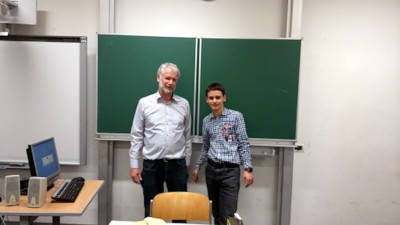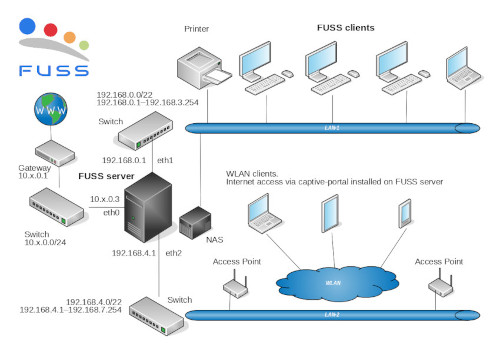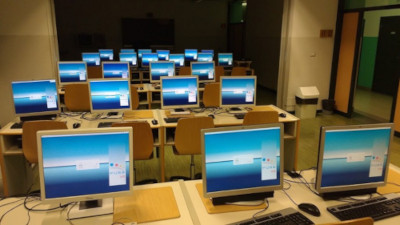All Italian-Language Schools in South Tyrol Migrated to Free Software
Location
The Autonomous Province of Bolzano, also known as South Tyrol 1, is located in northen Italy along the Italian and Austrian borders. Official languages in this province are Italian, German, and Ladin. The school system includes educational institutions to serve each of these linguistic communities.
About
The migration to free software of Italian public schools in South Tyrol was accomplished by the FUSS Project (Free Upgrade for a Digitally Sustainable School) 2 with initial funding from the European Social Fund, supported and sponsored by the Italian Education and Training Directorate of the Autonomous Province of Bolzano, administratively managed by the Vocational Training Institute “Luigi Einaudi” of Bolzano, in collaboration with the Education and Training Directorate and with the advice and cooperation of the IT company Truelite Srl as a technology partner.
The FUSS Project developed a complete GNU/Linux distribution called FUSS, a solution for servers, clients, and desktops based on Debian for managing an entire school network (Fig. 1).
FUSS was adopted in all of the 24 primary and secondary Italian schools, installed on 64 servers and around 5,000 computers (used by around 16,000 students and 1,900 teachers). It is also used in 22 public Italian kindergardens, installed on one PC for each class (a total of 65 classes).
FUSS has also been adopted outside the local public schools. The Provincial Music School “Vivaldi” in Bolzano uses exclusively FUSS (1 server, 40 PCs); the “Toniolo” Scientific and Sports High School runs FUSS in 1 server and 21 PCs. Outside South Tyrol, FUSS is run at the “Cornaro” Institute in Jesolo (Venice), the “Rodolico” High School in Florence, and the “Savoia-Benincasa” Institute in Ancona.
First-level support is provided in each school by at least one teacher who serves as an IT contact person, with a total of about 78 teachers throughout the district. They assist teachers and students, handle initial maintenance work, and respond to requests regarding installed software, new software, or training needs.
Every line of code developed as part of the FUSS Project is distributed under a GPLv3 or AGPLv3 license, and all documentation is available under a CC BY-SA license.
Motivation
The choice to use free software in schools is beyond economic or technical reasons, it is an ethical and political choice based on the values of computing freedom, access to information, and knowledge sharing.
The use of free software in both the public and private sectors in South Tyrol had been explicitly encouraged with the launch in 2004 of an Action Plan 3 that called for the adoption of free software and the establishement of a Free Software Competence Center. The document paved the way for the FUSS Project to follow up on those lines. Years later, FUSS was in full compliance with the new national legislation for software acquisition and reuse 4.
The FUSS Project team also believed (and this has been confirmed) that free software would result in economic savings, compared to the purchase of expensive recurring licenses from vendors such as Microsoft or Apple. It would also extend the life of hardware through free software-based replacements.
How We Did It
Planning began in January 2005, with an implementation phase during the summer of that year. FUSS went into operation in September, at the beginning of the new school year (2005/2006).
The project promoted a model of sustainable and democratic digitilization from the beginning, favored by local political parties and school leaders in Italian-speaking schools. A strong synergy and convergence of purpose was created between politics, public and private sectors.
Work started with an analysis of the state of the hardware in the entire school district, preparation of software packages—such as fuss-server (configuration of server-side services)—and fuss-client (configuration of networked PCs), and development of a set of tools to make server and client installation faster and more automated. Free replacements for proprietary applications previously used in the schools were found and adopted.
A comprehensive systems administration training course was also developed and implemented. The FUSS group, consisting of seven teachers and one administrator, was tasked not only with managing the technical side (hardware and software), but also with carrying out the activities to support teaching, helping teachers and students to better manage the resources available with the new FUSS environment.
As might be expected, typical barriers were encountered. There were users who did not want to step out of their comfort zone (because they were using Windows or MacOS on their private devices). Fortunately, these people were a minority: most teachers understood the importance of this change, and students started using GNU/Linux without any difficulty.
Commitment to Free Software
Over the years, server-side services have been added. Just to name the most significant ones: Octofuss (server and user management), Octomon (technical monitoring of installations), OctoNet (the management tool for each school), a provincial VPN network connecting all schools, and VOIP services for some schools.
Regarding the use of web (so-called “cloud”) applications, the FUSS Project for years has provided teachers with the e-learning platforms Moodle and Chamilo, LimeSurvey for surveys, and Group Office as a collaboration platform. The latter was replaced with NextCloud and LibreOffice Online, to which BigBlueButton (BBB) and PeerTube were added.
Results
Free Software offers schools and students unique educational opportunities. Students who find computers and their operation intriguing have the chance to work hands-on with technology without the restrictions imposed by proprietary licenses and unavailable source code.

Marco Marinello with Piergiorgio Cemin, teacher and former member of the FUSS Project. Copyright © 2016 Emiliano Vavassori. CC BY-SA 4.0
One example is the case of high school student Marco Marinello 5, who began volunteering for the development of the project and ultimately found himself programming, learning languages such as HTML, Bash scripting and Python on his own. Marco then ported the FUSS distribution to ARM processors and installed Raspberry Pi in the computer lab of one of the schools in Bolzano. He also gave several presentations to teachers and technicians at his school.
“FUSS has given me the great opportunity to approach and learn the importance of Free Software and for that I am very grateful.”
—Marco Marinello- Students and teachers can work at home with the same free tools used at school without any cost burden on families.
- Public money has been spent to create public value (code, documentation, shared experience) by helping to achieve in the digital sphere the primary goal of the school: the sharing of knowledge.
- The FUSS Project created new software and manuals, reused and modified existing ones, and shared the results not only nationally but also internationally.
Tips for Success
Here are some pieces of advice, in the hope that the experience of the FUSS Project may help other schools achieve success in migrating to free software as a powerful engine for teaching and technological freedom and innovation.
- In presenting a project plan to your school or school district, in addition to highlighting the ethical reasons and all the technical and economic benefits, emphasize how sustainable digitalization based on free software, open formats, and freely available educational materials improves knowledge sharing, promotes nontraditional educational opportunities, and extends access to students and families that might not otherwise have with proprietary systems.
- Do not underestimate the importance of communicating and collaborating with teachers, managers, students, their families, local political leaders, and the community as a whole, including local free software communities (GNU/Linux User Groups, Hacker Spaces, Fab Labs, etc.).
- Of uttermost importance is training, to help all participants get acquainted and feel comfortable with the new environment.
- Do not try to reinvent the wheel, reuse what is freely available. Look around to see if there are examples of other institutions, schools, associations that you can follow and what free software you wish to reuse.
- One step at a time. Suggest the adoption of free/libre packages such as LibreOffice to your local public administration; this will positively influence their perception of free software as it will prove an efficient tool with nothing to envy its proprietary counterparts.
- Invest money in motivated people, regardless of their role—technicians, developers, teachers, students.
- Finally, share everything you create (software, documentation, teaching materials). By doing so, you will be spreading the word about your work and creating awarness about the benefits of sharing.
The FUSS Project is happy to share its experience with you at any time. Write to <[email protected]>.
1. South Tyrol in Wikipedia.
2. The FUSS Project.
3. e-Südtirol Action Plan for the development of the information society in Alto Adige, sections 3.12 and 3.13 (in Italian) (in German).
4. Digital Administration Code (CAD), Articles 68 and 69 on PA acquisition and reuse of software, and Guidelines for the acquisition and reuse of software in public administrations (both in Italian).


The following information was extracted from a report submitted to us by Paolo Dongilli, Technical Inspector and Coordinator of the FUSS Project, and member of the Italian School Board of the Autonomous Province of Bolzano.